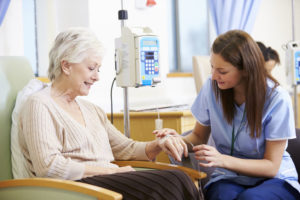Chemotherapy in the elderly
Older patients are a special case when it comes to chemotherapy dosing. The stresses chemotherapy puts on the body are better weathered by young people. Elderly people are more likely to have co-morbidities and their immune systems are weaker and the most vulnerable organs may be less capable of handling the medicine.
The other challenge is that clinical trials done during development of drugs usually involve younger patients. So age-specific issues are often unknown until the medicine is widely used. Patients with liver or kidney problems are often excluded from clinical trials and many elderly people have those problems. The liver detoxifies and metabolizes chemicals in the body from food and also that are administered as medicine. When people die from poisoning, the actual cause of death is often liver failure as the liver cannot keep up with the load of exogenous material it is called on to process. In old age the size of the liver declines and the rate of blood flow to the liver also declines. The capacity declines and drug elimination and metabolism are slower than they are in younger patients. That means the time-average concentration of the drug in the bloodstream remains higher than they are for young patients. The glomerular filtration rate (GFR) of kidneys tends to decline with age: kidneys are less effective in the elderly. Kidney function declines slowly over the course of life, including in people without high blood pressure or kidney disease. Elimination of drugs is slower. The other wrinkle comes from the fact that chemotherapy often causes diarrhea or vomiting as a side effect and the medical team needs to worry about hydration of the patient.
 Body fat quantity and distribution affects how and where medicines go in the body. While a young person may have only 15 percent body fat, the older person typically has 30 percent. intracellular water decreases with age from about 42 percent in the average 25-year-old to 33 percent in a 75-year-old. Some chemotherapy produces the side effect of anemia and neutropenia, but elderly people often already have diminished bone marrows and the capability to produce blood cells, so these side effects are worse in the elderly. Anthracycline agents are particularly hard on the heart muscle and like other organs; these is often weaker in older people.
Body fat quantity and distribution affects how and where medicines go in the body. While a young person may have only 15 percent body fat, the older person typically has 30 percent. intracellular water decreases with age from about 42 percent in the average 25-year-old to 33 percent in a 75-year-old. Some chemotherapy produces the side effect of anemia and neutropenia, but elderly people often already have diminished bone marrows and the capability to produce blood cells, so these side effects are worse in the elderly. Anthracycline agents are particularly hard on the heart muscle and like other organs; these is often weaker in older people.
Polypharmacy – the syndrome of taking many medicines at once – is not studied in clinical trials either, and elderly people take about three times as many medications as younger adults. The presence of these other medicines can make the chemotherapy drug stronger or weaker. Dexamethasone, anticonvulsants, and alcohol act in the liver to increase the activity of enzymes in the P450 pathway. This results in faster metabolism of the chemotherapy agent. Other medicines work the opposite way and inhibit those enzymes, thereby making the chemotherapy more potent.
Because older people tend to have more co-morbidities, many cancer centers have their patients undergo a geriatric assessment before beginning treatment.
Over 50 percent of people with cancer in the United States are over 65, so nurses and doctors take an interest in how chemotherapy works in the bodies of older patients.
See: The Lancet: Is cancer biology different in older patients?